MIS602: File-Based Database Design and Data Modelling Report
VerifiedAdded on 2022/08/20
|9
|1264
|11
Report
AI Summary
This report details a student's assignment on data modelling and database design, focusing on a file-based system for Torrens University Australia (TUA). The report begins with an introduction to database concepts, file-based databases, and data modelling. It then identifies key data attributes, such as student ID, names, and course details. The core of the report outlines four versions of the database, illustrating operations like data insertion, deletion, and updates. Each version is visualized with tables showcasing changes to the data. The report concludes by discussing the limitations of file-based systems compared to modern database management systems, while acknowledging their relevance for small-scale data management. The student successfully models and designs a file-based database, demonstrating an understanding of data structure and manipulation.
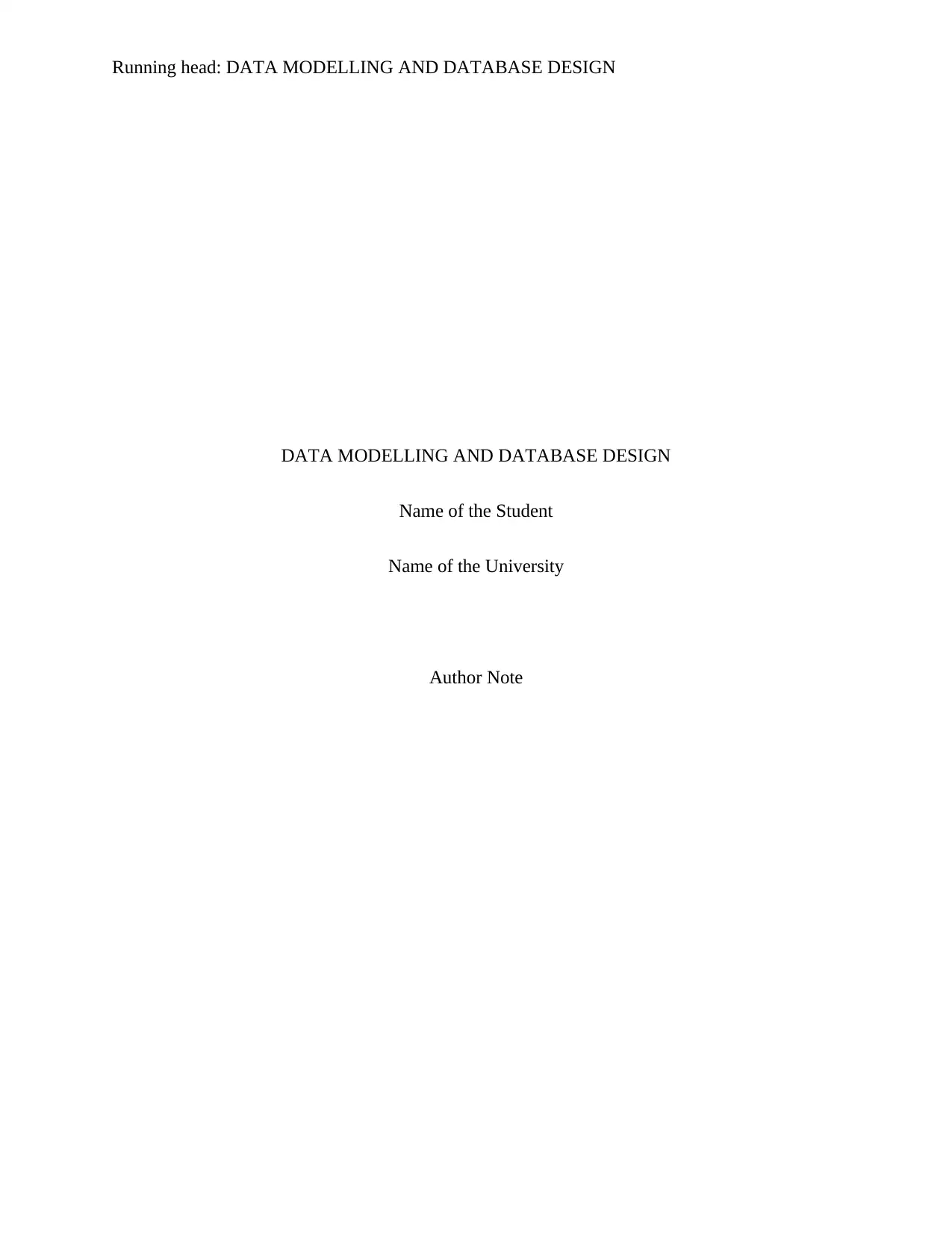
Running head: DATA MODELLING AND DATABASE DESIGN
DATA MODELLING AND DATABASE DESIGN
Name of the Student
Name of the University
Author Note
DATA MODELLING AND DATABASE DESIGN
Name of the Student
Name of the University
Author Note
Paraphrase This Document
Need a fresh take? Get an instant paraphrase of this document with our AI Paraphraser
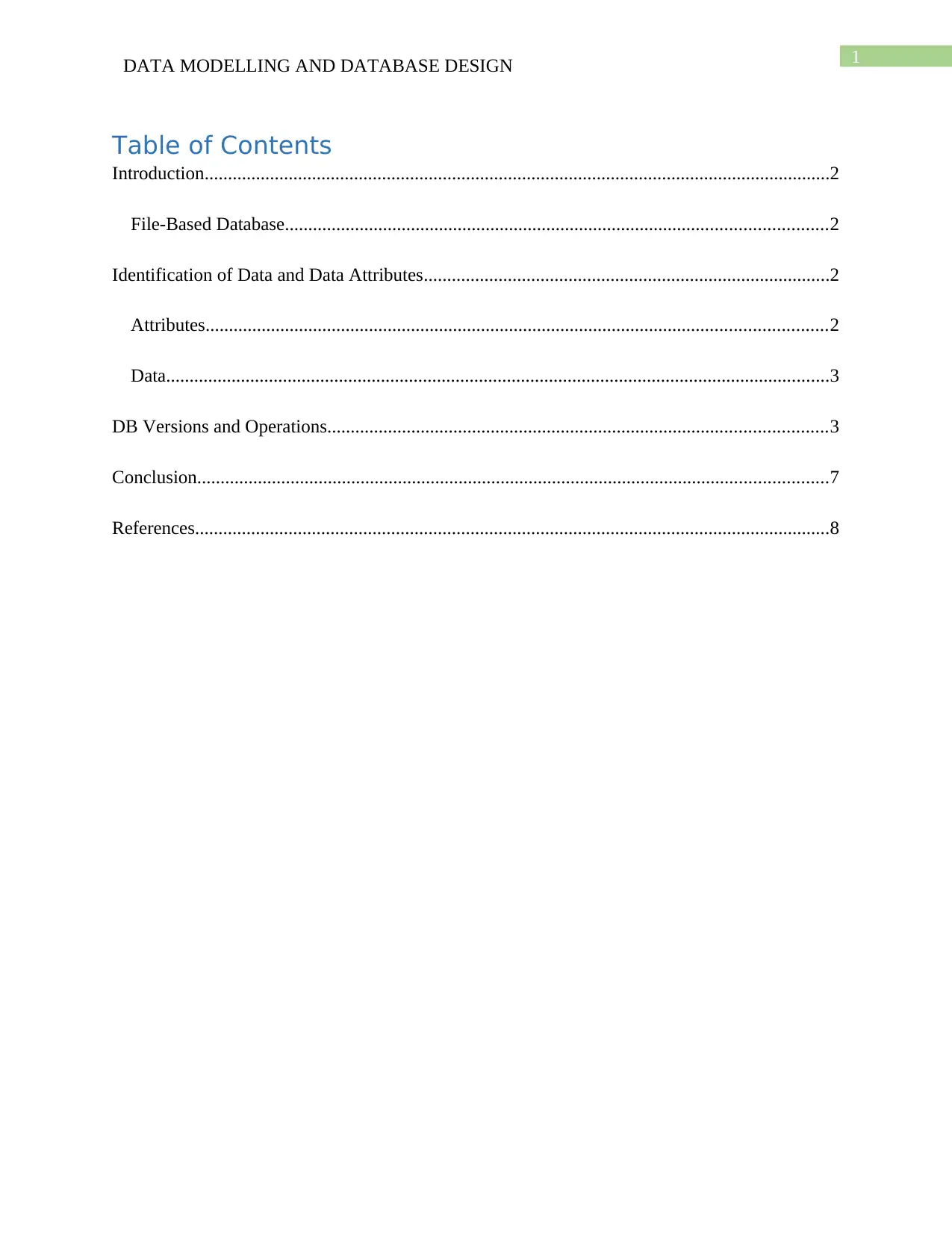
1DATA MODELLING AND DATABASE DESIGN
Table of Contents
Introduction......................................................................................................................................2
File-Based Database....................................................................................................................2
Identification of Data and Data Attributes.......................................................................................2
Attributes.....................................................................................................................................2
Data..............................................................................................................................................3
DB Versions and Operations...........................................................................................................3
Conclusion.......................................................................................................................................7
References........................................................................................................................................8
Table of Contents
Introduction......................................................................................................................................2
File-Based Database....................................................................................................................2
Identification of Data and Data Attributes.......................................................................................2
Attributes.....................................................................................................................................2
Data..............................................................................................................................................3
DB Versions and Operations...........................................................................................................3
Conclusion.......................................................................................................................................7
References........................................................................................................................................8
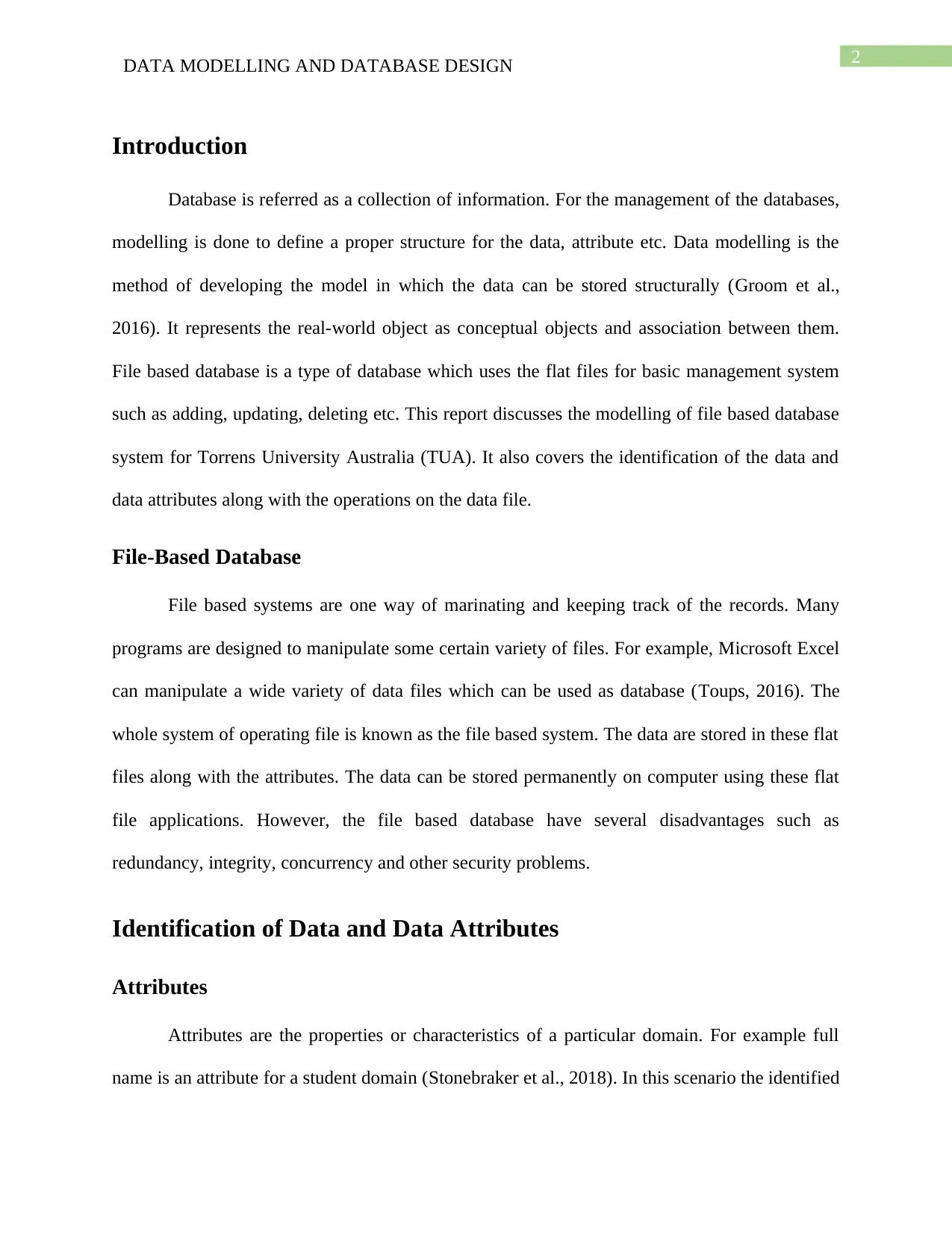
2DATA MODELLING AND DATABASE DESIGN
Introduction
Database is referred as a collection of information. For the management of the databases,
modelling is done to define a proper structure for the data, attribute etc. Data modelling is the
method of developing the model in which the data can be stored structurally (Groom et al.,
2016). It represents the real-world object as conceptual objects and association between them.
File based database is a type of database which uses the flat files for basic management system
such as adding, updating, deleting etc. This report discusses the modelling of file based database
system for Torrens University Australia (TUA). It also covers the identification of the data and
data attributes along with the operations on the data file.
File-Based Database
File based systems are one way of marinating and keeping track of the records. Many
programs are designed to manipulate some certain variety of files. For example, Microsoft Excel
can manipulate a wide variety of data files which can be used as database (Toups, 2016). The
whole system of operating file is known as the file based system. The data are stored in these flat
files along with the attributes. The data can be stored permanently on computer using these flat
file applications. However, the file based database have several disadvantages such as
redundancy, integrity, concurrency and other security problems.
Identification of Data and Data Attributes
Attributes
Attributes are the properties or characteristics of a particular domain. For example full
name is an attribute for a student domain (Stonebraker et al., 2018). In this scenario the identified
Introduction
Database is referred as a collection of information. For the management of the databases,
modelling is done to define a proper structure for the data, attribute etc. Data modelling is the
method of developing the model in which the data can be stored structurally (Groom et al.,
2016). It represents the real-world object as conceptual objects and association between them.
File based database is a type of database which uses the flat files for basic management system
such as adding, updating, deleting etc. This report discusses the modelling of file based database
system for Torrens University Australia (TUA). It also covers the identification of the data and
data attributes along with the operations on the data file.
File-Based Database
File based systems are one way of marinating and keeping track of the records. Many
programs are designed to manipulate some certain variety of files. For example, Microsoft Excel
can manipulate a wide variety of data files which can be used as database (Toups, 2016). The
whole system of operating file is known as the file based system. The data are stored in these flat
files along with the attributes. The data can be stored permanently on computer using these flat
file applications. However, the file based database have several disadvantages such as
redundancy, integrity, concurrency and other security problems.
Identification of Data and Data Attributes
Attributes
Attributes are the properties or characteristics of a particular domain. For example full
name is an attribute for a student domain (Stonebraker et al., 2018). In this scenario the identified
⊘ This is a preview!⊘
Do you want full access?
Subscribe today to unlock all pages.

Trusted by 1+ million students worldwide
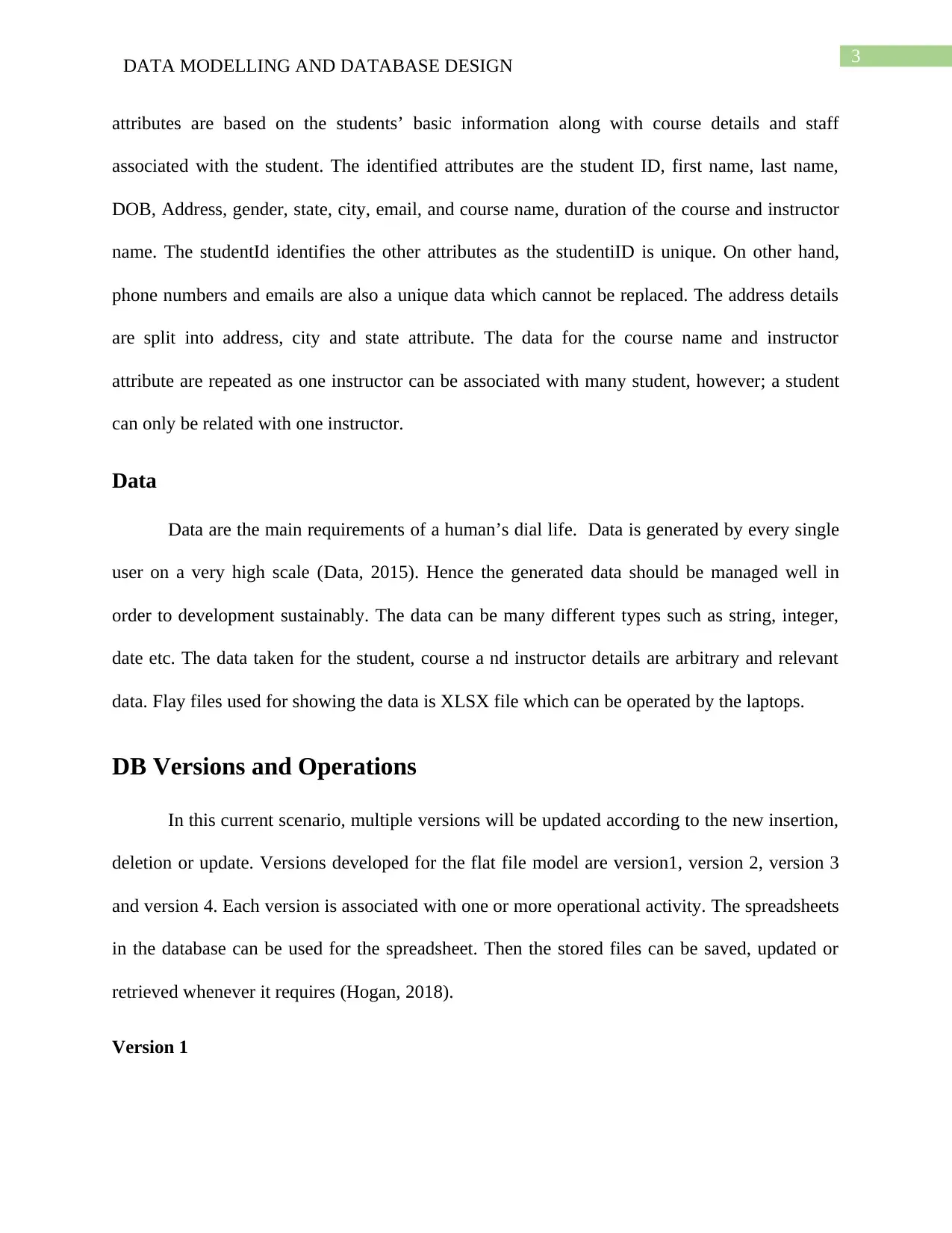
3DATA MODELLING AND DATABASE DESIGN
attributes are based on the students’ basic information along with course details and staff
associated with the student. The identified attributes are the student ID, first name, last name,
DOB, Address, gender, state, city, email, and course name, duration of the course and instructor
name. The studentId identifies the other attributes as the studentiID is unique. On other hand,
phone numbers and emails are also a unique data which cannot be replaced. The address details
are split into address, city and state attribute. The data for the course name and instructor
attribute are repeated as one instructor can be associated with many student, however; a student
can only be related with one instructor.
Data
Data are the main requirements of a human’s dial life. Data is generated by every single
user on a very high scale (Data, 2015). Hence the generated data should be managed well in
order to development sustainably. The data can be many different types such as string, integer,
date etc. The data taken for the student, course a nd instructor details are arbitrary and relevant
data. Flay files used for showing the data is XLSX file which can be operated by the laptops.
DB Versions and Operations
In this current scenario, multiple versions will be updated according to the new insertion,
deletion or update. Versions developed for the flat file model are version1, version 2, version 3
and version 4. Each version is associated with one or more operational activity. The spreadsheets
in the database can be used for the spreadsheet. Then the stored files can be saved, updated or
retrieved whenever it requires (Hogan, 2018).
Version 1
attributes are based on the students’ basic information along with course details and staff
associated with the student. The identified attributes are the student ID, first name, last name,
DOB, Address, gender, state, city, email, and course name, duration of the course and instructor
name. The studentId identifies the other attributes as the studentiID is unique. On other hand,
phone numbers and emails are also a unique data which cannot be replaced. The address details
are split into address, city and state attribute. The data for the course name and instructor
attribute are repeated as one instructor can be associated with many student, however; a student
can only be related with one instructor.
Data
Data are the main requirements of a human’s dial life. Data is generated by every single
user on a very high scale (Data, 2015). Hence the generated data should be managed well in
order to development sustainably. The data can be many different types such as string, integer,
date etc. The data taken for the student, course a nd instructor details are arbitrary and relevant
data. Flay files used for showing the data is XLSX file which can be operated by the laptops.
DB Versions and Operations
In this current scenario, multiple versions will be updated according to the new insertion,
deletion or update. Versions developed for the flat file model are version1, version 2, version 3
and version 4. Each version is associated with one or more operational activity. The spreadsheets
in the database can be used for the spreadsheet. Then the stored files can be saved, updated or
retrieved whenever it requires (Hogan, 2018).
Version 1
Paraphrase This Document
Need a fresh take? Get an instant paraphrase of this document with our AI Paraphraser
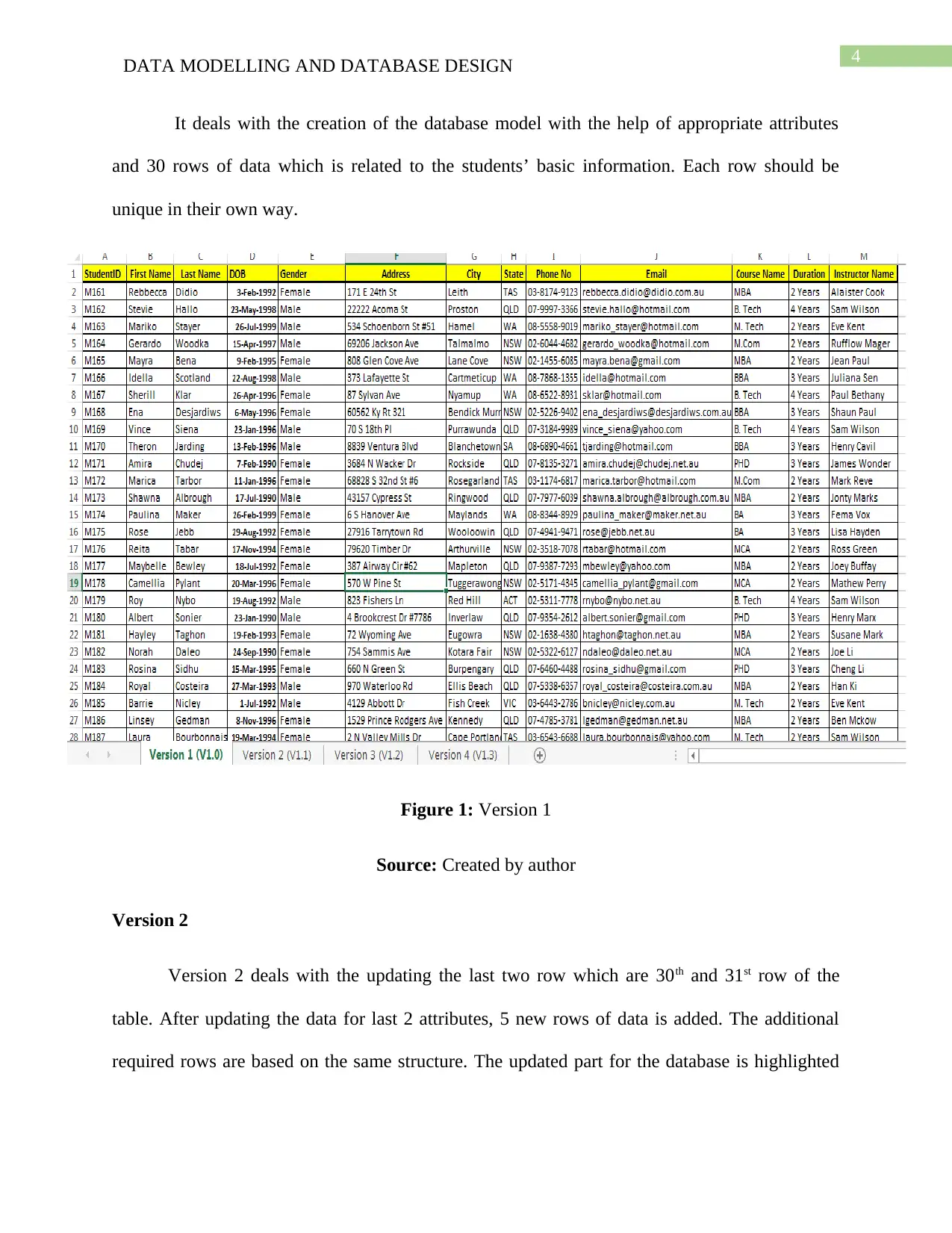
4DATA MODELLING AND DATABASE DESIGN
It deals with the creation of the database model with the help of appropriate attributes
and 30 rows of data which is related to the students’ basic information. Each row should be
unique in their own way.
Figure 1: Version 1
Source: Created by author
Version 2
Version 2 deals with the updating the last two row which are 30th and 31st row of the
table. After updating the data for last 2 attributes, 5 new rows of data is added. The additional
required rows are based on the same structure. The updated part for the database is highlighted
It deals with the creation of the database model with the help of appropriate attributes
and 30 rows of data which is related to the students’ basic information. Each row should be
unique in their own way.
Figure 1: Version 1
Source: Created by author
Version 2
Version 2 deals with the updating the last two row which are 30th and 31st row of the
table. After updating the data for last 2 attributes, 5 new rows of data is added. The additional
required rows are based on the same structure. The updated part for the database is highlighted
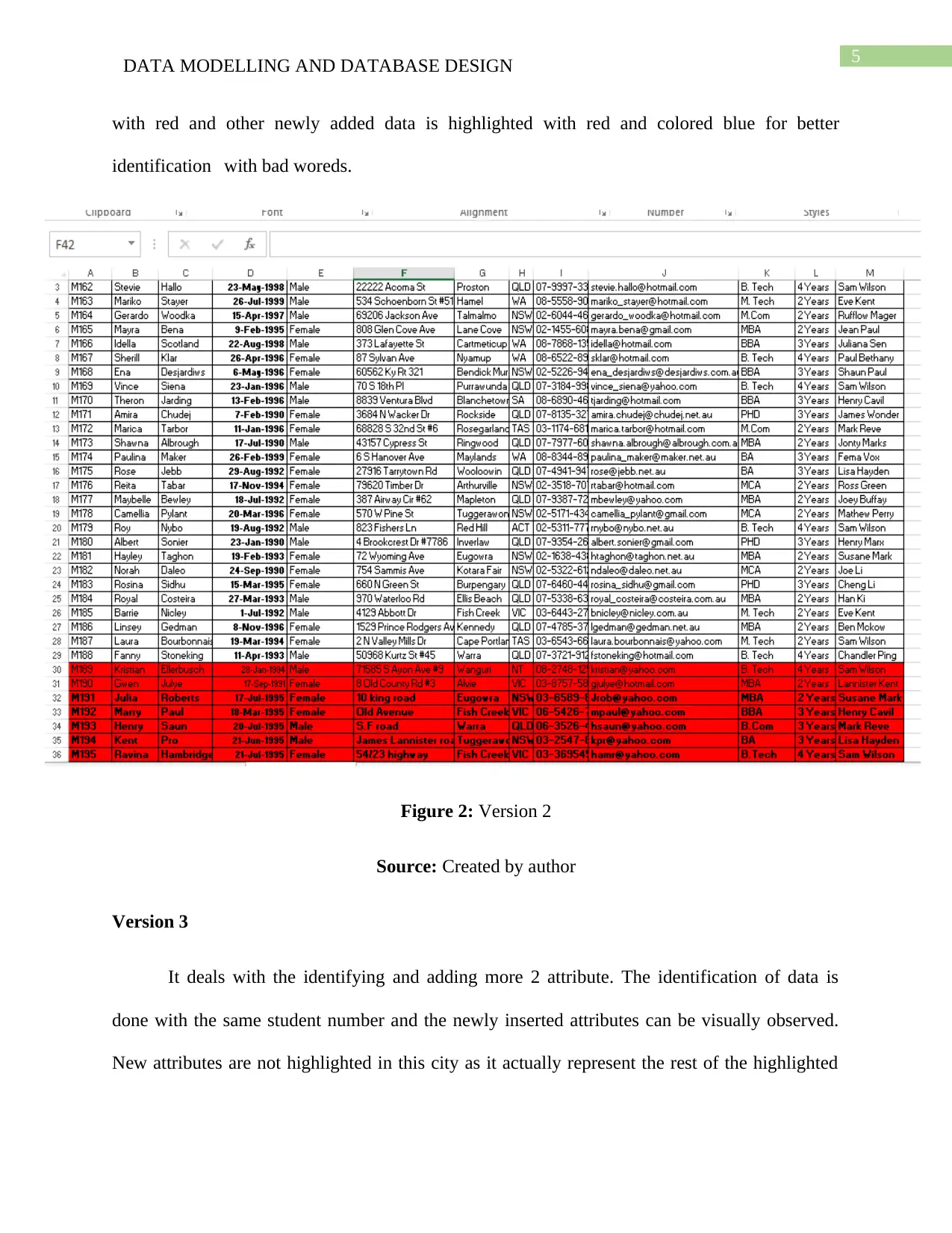
5DATA MODELLING AND DATABASE DESIGN
with red and other newly added data is highlighted with red and colored blue for better
identification with bad woreds.
Figure 2: Version 2
Source: Created by author
Version 3
It deals with the identifying and adding more 2 attribute. The identification of data is
done with the same student number and the newly inserted attributes can be visually observed.
New attributes are not highlighted in this city as it actually represent the rest of the highlighted
with red and other newly added data is highlighted with red and colored blue for better
identification with bad woreds.
Figure 2: Version 2
Source: Created by author
Version 3
It deals with the identifying and adding more 2 attribute. The identification of data is
done with the same student number and the newly inserted attributes can be visually observed.
New attributes are not highlighted in this city as it actually represent the rest of the highlighted
⊘ This is a preview!⊘
Do you want full access?
Subscribe today to unlock all pages.

Trusted by 1+ million students worldwide
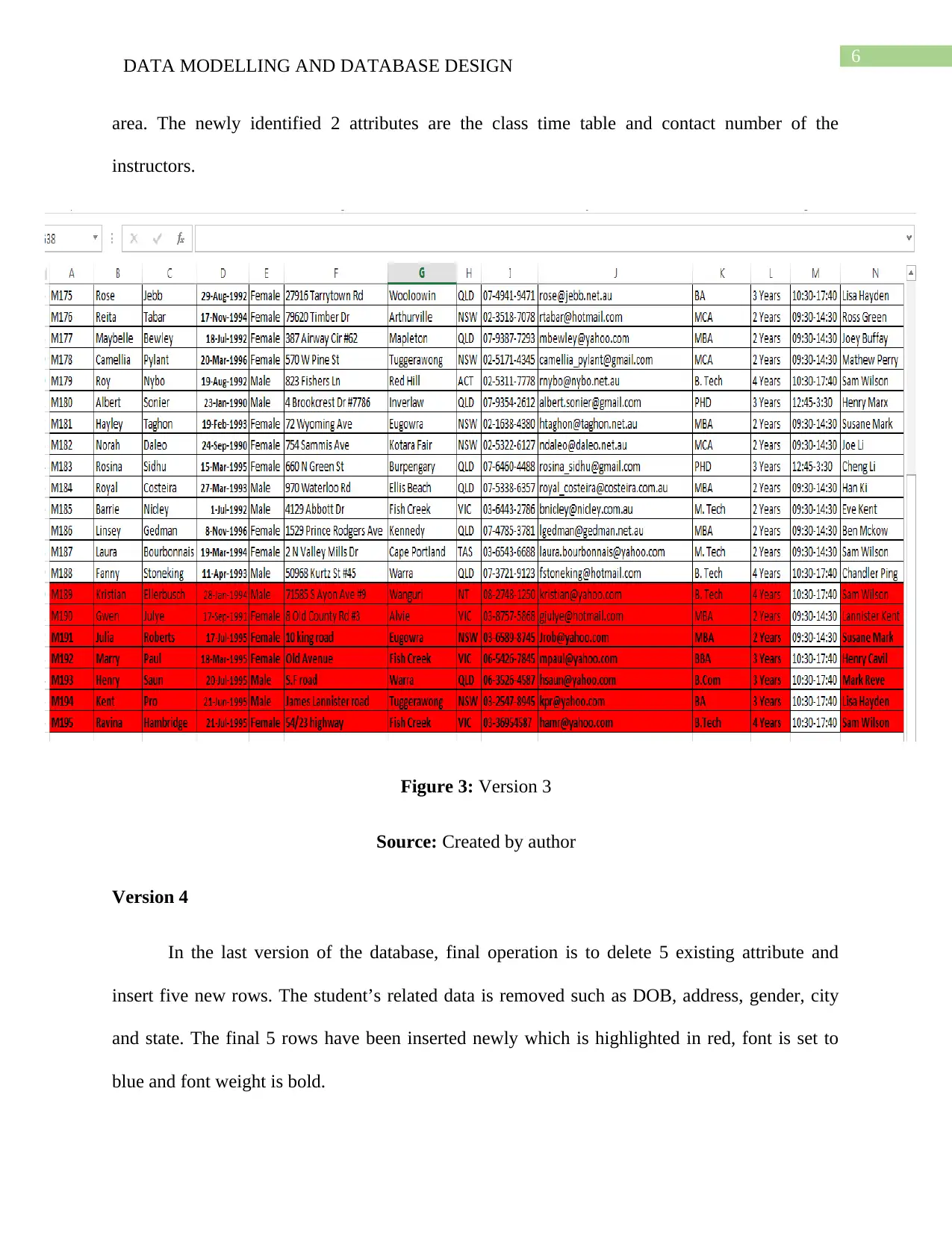
6DATA MODELLING AND DATABASE DESIGN
area. The newly identified 2 attributes are the class time table and contact number of the
instructors.
Figure 3: Version 3
Source: Created by author
Version 4
In the last version of the database, final operation is to delete 5 existing attribute and
insert five new rows. The student’s related data is removed such as DOB, address, gender, city
and state. The final 5 rows have been inserted newly which is highlighted in red, font is set to
blue and font weight is bold.
area. The newly identified 2 attributes are the class time table and contact number of the
instructors.
Figure 3: Version 3
Source: Created by author
Version 4
In the last version of the database, final operation is to delete 5 existing attribute and
insert five new rows. The student’s related data is removed such as DOB, address, gender, city
and state. The final 5 rows have been inserted newly which is highlighted in red, font is set to
blue and font weight is bold.
Paraphrase This Document
Need a fresh take? Get an instant paraphrase of this document with our AI Paraphraser
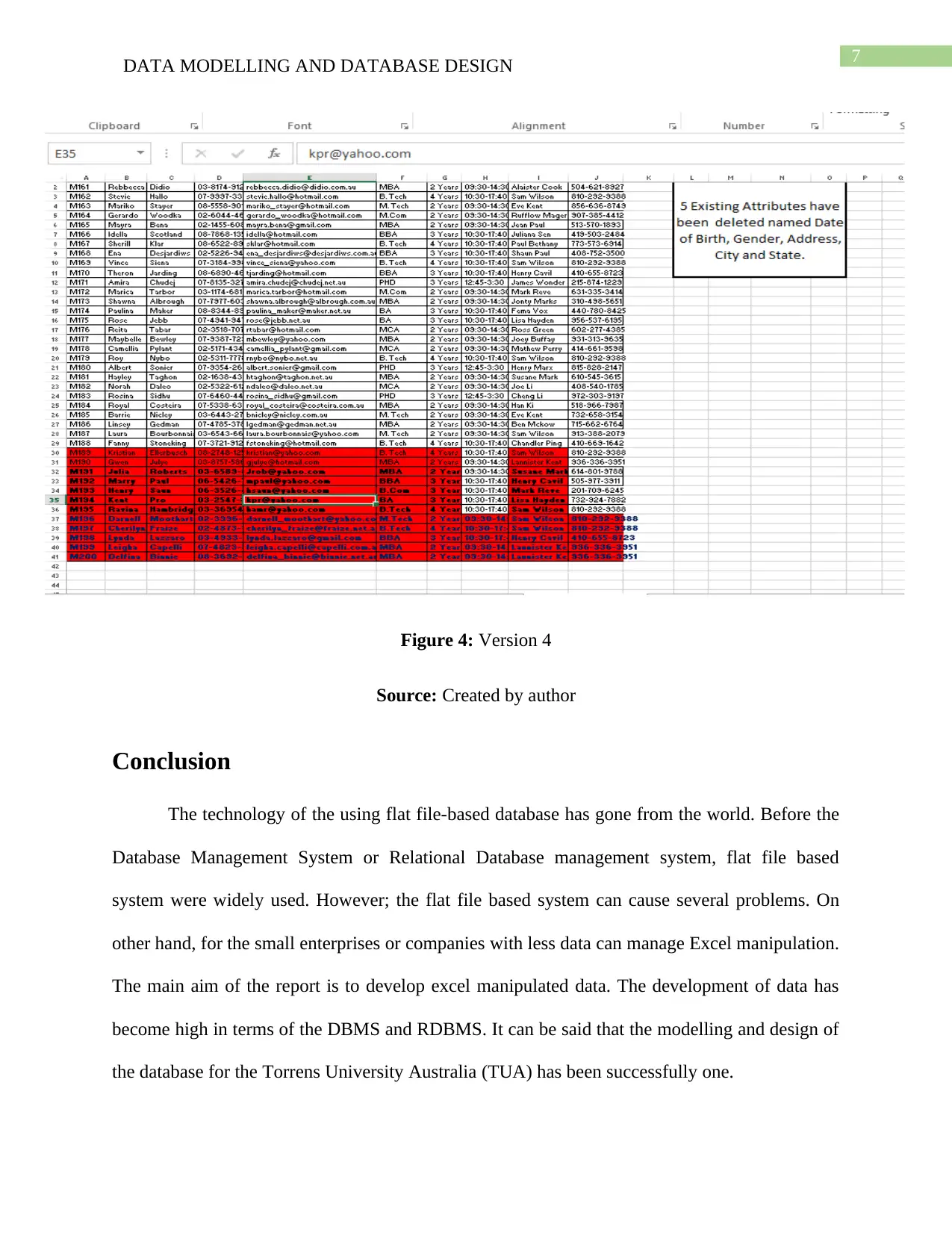
7DATA MODELLING AND DATABASE DESIGN
Figure 4: Version 4
Source: Created by author
Conclusion
The technology of the using flat file-based database has gone from the world. Before the
Database Management System or Relational Database management system, flat file based
system were widely used. However; the flat file based system can cause several problems. On
other hand, for the small enterprises or companies with less data can manage Excel manipulation.
The main aim of the report is to develop excel manipulated data. The development of data has
become high in terms of the DBMS and RDBMS. It can be said that the modelling and design of
the database for the Torrens University Australia (TUA) has been successfully one.
Figure 4: Version 4
Source: Created by author
Conclusion
The technology of the using flat file-based database has gone from the world. Before the
Database Management System or Relational Database management system, flat file based
system were widely used. However; the flat file based system can cause several problems. On
other hand, for the small enterprises or companies with less data can manage Excel manipulation.
The main aim of the report is to develop excel manipulated data. The development of data has
become high in terms of the DBMS and RDBMS. It can be said that the modelling and design of
the database for the Torrens University Australia (TUA) has been successfully one.
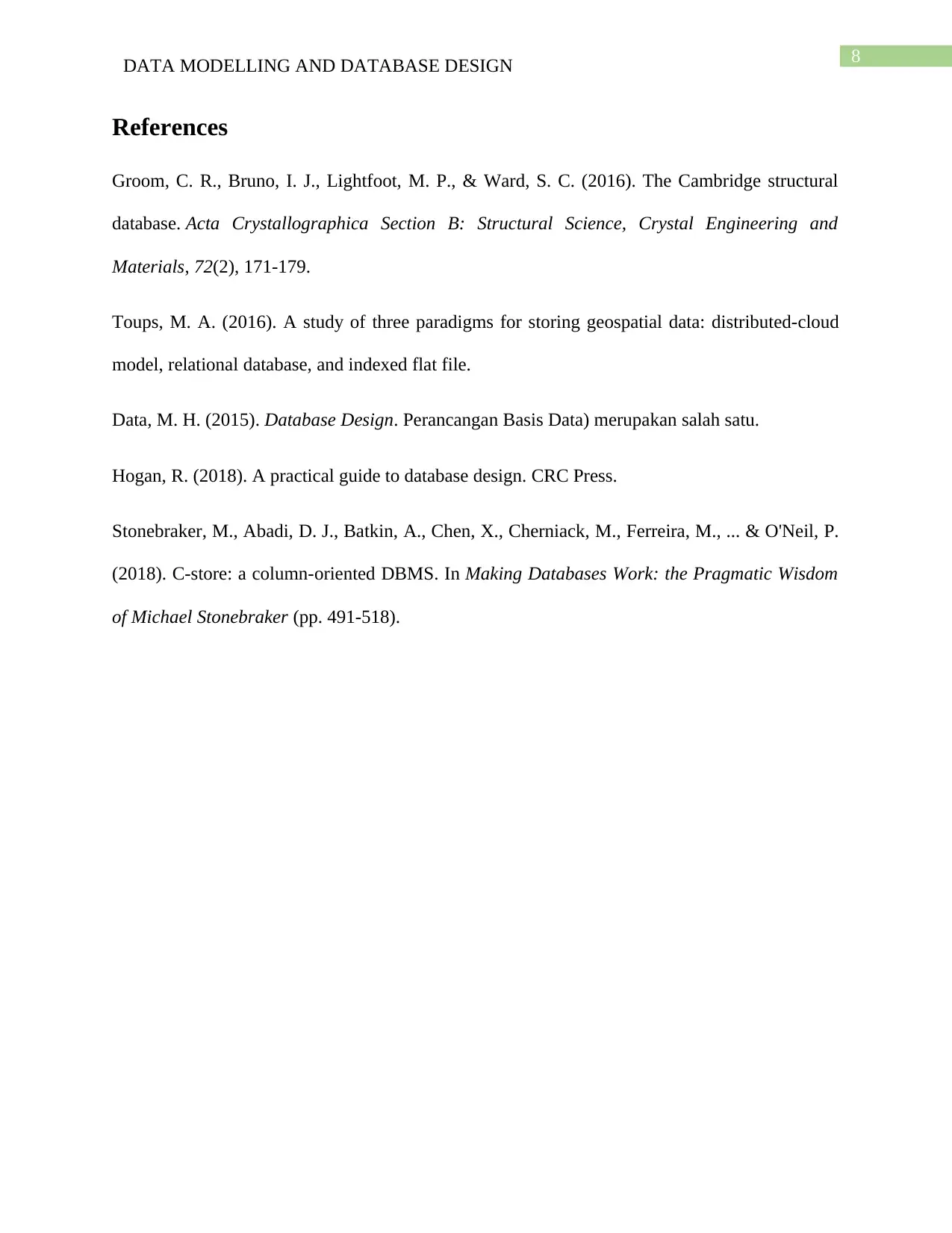
8DATA MODELLING AND DATABASE DESIGN
References
Groom, C. R., Bruno, I. J., Lightfoot, M. P., & Ward, S. C. (2016). The Cambridge structural
database. Acta Crystallographica Section B: Structural Science, Crystal Engineering and
Materials, 72(2), 171-179.
Toups, M. A. (2016). A study of three paradigms for storing geospatial data: distributed-cloud
model, relational database, and indexed flat file.
Data, M. H. (2015). Database Design. Perancangan Basis Data) merupakan salah satu.
Hogan, R. (2018). A practical guide to database design. CRC Press.
Stonebraker, M., Abadi, D. J., Batkin, A., Chen, X., Cherniack, M., Ferreira, M., ... & O'Neil, P.
(2018). C-store: a column-oriented DBMS. In Making Databases Work: the Pragmatic Wisdom
of Michael Stonebraker (pp. 491-518).
References
Groom, C. R., Bruno, I. J., Lightfoot, M. P., & Ward, S. C. (2016). The Cambridge structural
database. Acta Crystallographica Section B: Structural Science, Crystal Engineering and
Materials, 72(2), 171-179.
Toups, M. A. (2016). A study of three paradigms for storing geospatial data: distributed-cloud
model, relational database, and indexed flat file.
Data, M. H. (2015). Database Design. Perancangan Basis Data) merupakan salah satu.
Hogan, R. (2018). A practical guide to database design. CRC Press.
Stonebraker, M., Abadi, D. J., Batkin, A., Chen, X., Cherniack, M., Ferreira, M., ... & O'Neil, P.
(2018). C-store: a column-oriented DBMS. In Making Databases Work: the Pragmatic Wisdom
of Michael Stonebraker (pp. 491-518).
⊘ This is a preview!⊘
Do you want full access?
Subscribe today to unlock all pages.

Trusted by 1+ million students worldwide
1 out of 9
Related Documents
Your All-in-One AI-Powered Toolkit for Academic Success.
+13062052269
info@desklib.com
Available 24*7 on WhatsApp / Email
![[object Object]](/_next/static/media/star-bottom.7253800d.svg)
Unlock your academic potential
Copyright © 2020–2025 A2Z Services. All Rights Reserved. Developed and managed by ZUCOL.




